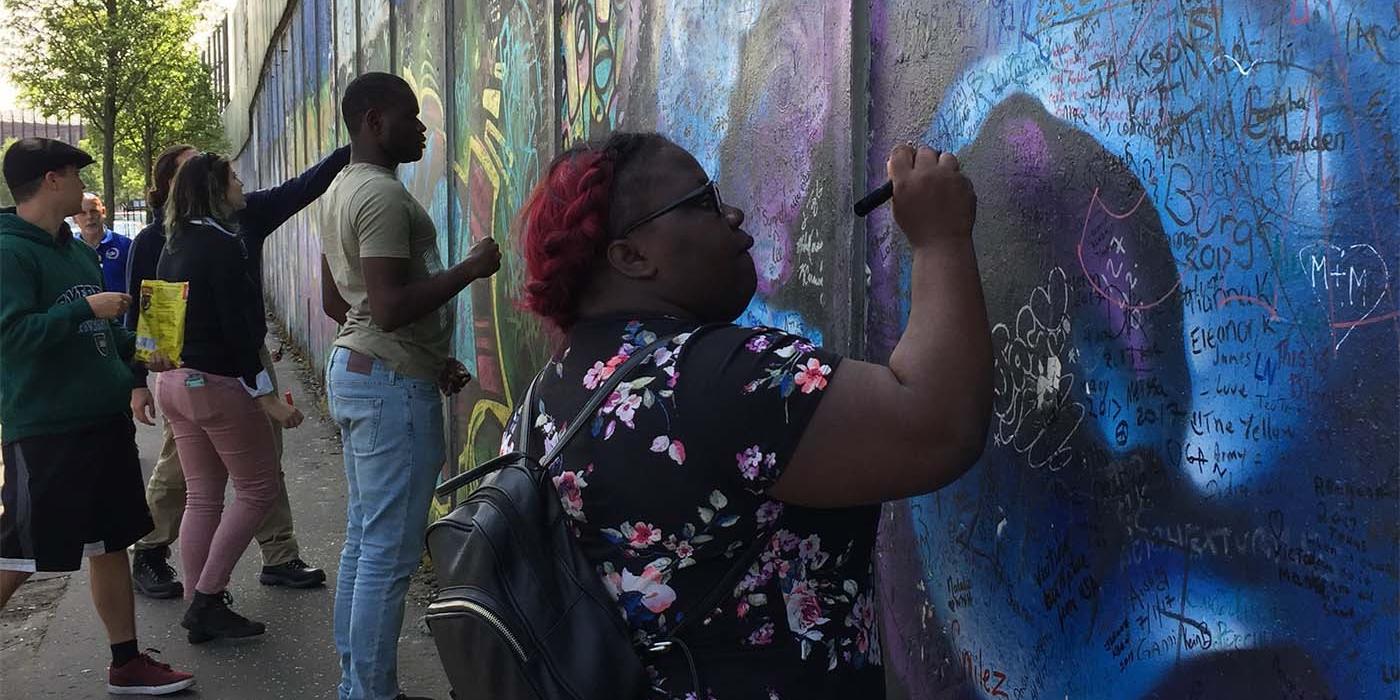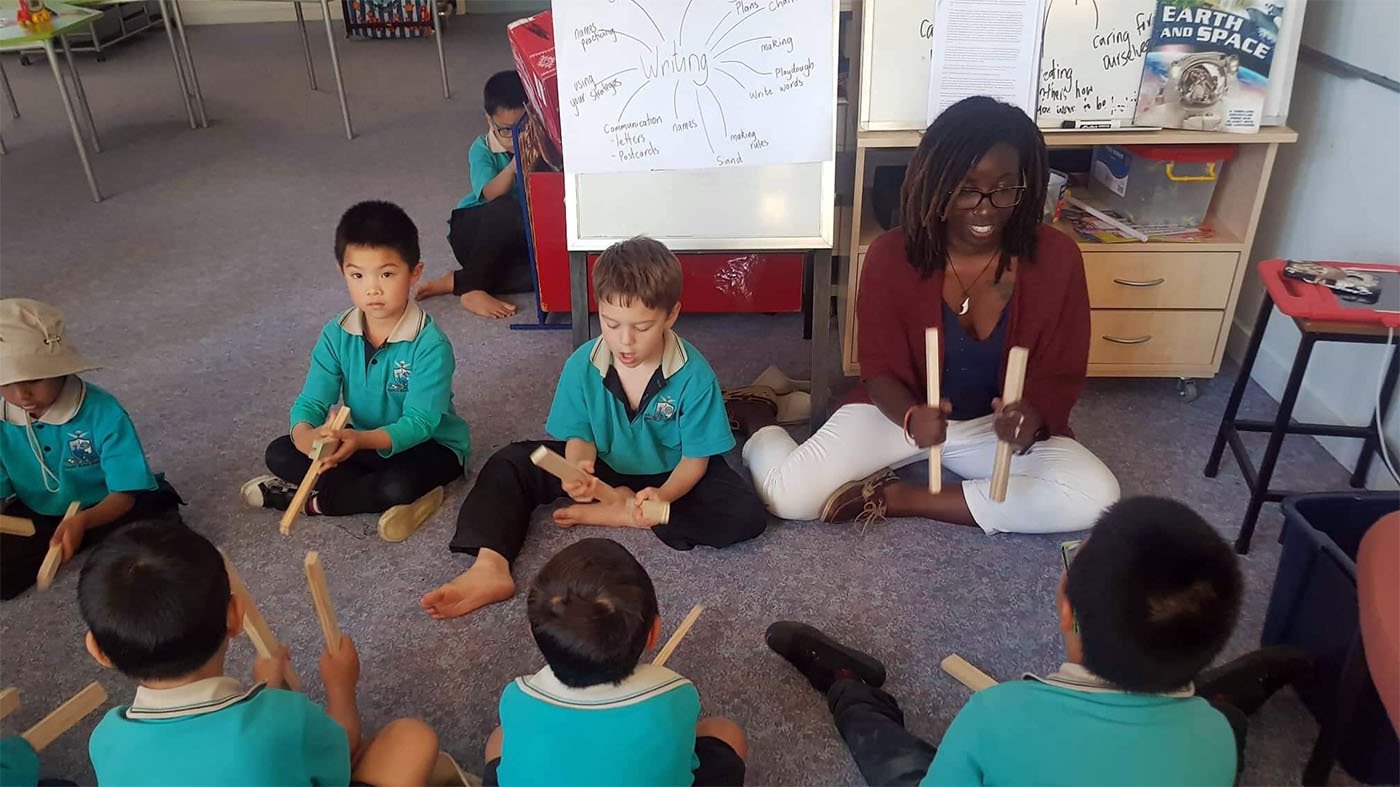2022 Comprehensive College of Lake County
As a public community college and Hispanic-Serving Institution, the College of Lake County (CLC) focuses on creating equitable international engagement opportunities for its 14,000 undergraduate students through strategic partnerships, study abroad programs, and curriculum internationalization. A new physical space and revamped governance structure for global engagement have helped put internationalization at the center of campus culture at CLC, located in Grayslake, Illinois.
A renovated student center in the heart of the College of Lake County’s campus in Grayslake, Illinois, gave international programs more visibility, complete with a Global Community Hall that was dedicated in 2020. The hall is adorned with flags representing the home countries of the student population.
“The physical presence has really helped to solidify our transition from two people working really hard in an office to help international students and study abroad students to a full-fledged center with four full-time staff guiding strategic initiatives for the college,” says Jacob Cushing, director of student records and global engagement.
The physical renovation has gone hand in hand with a strategic focus on internationalization. “We’ve thought strategically and purposefully over the past 7 to 8 years about how best to ensure that we are graduating students to be productive members in a global society,” Cushing says.
Doyoung Kim, an engineering major from South Korea, first came to CLC in 2014 to study English as a second language. Part way through his education, he had to return to Korea to complete his required military service. When he started at the college, there were a lot of international students but little sense of community among them.
When he returned to Illinois in 2020, he immediately noticed the change that resulted due to the international office’s new location. “We have a really large space to connect and get to know each other,” he says.
Even though he had already been at the college for several years, Kim took ELI 125: Introduction to American College Culture, an international student success course. He says it helps international students to understand the resources the college has to offer and how to be successful in higher education at CLC. Topics include the U.S. grading system, Western learning and teaching styles, personal and academic support structures within the college, differences in academic requirements and expectations, appropriate classroom behavior, and healthy and safe acclimation to the academic and social college environment.
In July 2021, all international program units were officially consolidated into the Department of Global Engagement (DGE). Erin Fowles, dean of enrollment services, oversees the DGE along with five other departments. Cushing, who was hired in 2014 as an international student adviser, was the right person to lead the new department, she says.
Creating the director position was instrumental in pushing comprehensive internationalization on campus, Fowles says, because “you’ve then got someone who can demonstrate on a regular basis the value of internationalization to the campus.”
Prior to the creation of the new department, study abroad was 25 percent of a role for an administrator in another division and there were no initiatives focused on curriculum internationalization. Now DGE oversees education abroad, international student services, curriculum internationalization, international partnerships, and globally focused campus and community programming.
"The support from our leadership to reorganize the Department of Global Engagement as the central hub has allowed us to really build on that momentum to push us forward,” Cushing says.
Another effort to coordinate CLC’s internationalization efforts is the Global Engagement Committee (GEC), which meets regularly to advise and promote projects and programs of the DGE. The committee is comprised of representatives from all academic divisions and more than 10 different administrative units, including the college foundation, financial aid, academic advising, the diversity office, and student life. The committee also includes an international student representative.
Members of the GEC make presentations to the faculty senate, propose new initiatives and garner feedback from the Board of Trustees, ensuring all divisions and departments can participate in driving the college’s internationalization efforts.
Engaging Faculty Internationally
Using the Community Colleges for International Development’s Framework for Comprehensive Internationalization, CLC identified faculty engagement as one of the immediate goals for the new department. Cushing worked with the educational affairs department and human resources to secure course release time for two faculty members to collaborate with the DGE. They are helping to recruit, train, and support faculty members to lead study abroad programs, as well as working to identify and add more courses with international content.
The two faculty leaders helped develop the Global Citizenship Milestone program as a way to internationalize the curriculum. If students complete 12 credits of international or multicultural courses, they receive a Global Citizenship Milestone notation on their transcript. While study abroad can account for half of the required credits, the goal was to design a program that was accessible to all students.
“In terms of equity, we realize not everyone’s going to be able to study abroad,” Cushing says. “This program touches that equity piece so that all students have the opportunity to engage and develop a global citizenship mindset.”
Most of CLC’s degree programs require students to take at least one course that is designated as international or multicultural. But students didn’t always know which courses met that requirement. Now students use a regularly updated list of all approved courses.
“I would call this a strategic repurposing of what was already being offered at CLC,” Cushing says. “Instead of reinventing the wheel and putting a lot of work into building something new, we’ve repurposed those classes that are already offered. And it’s now used as a recruitment tool to get students into those courses.”
One of the new faculty leaders is English Language Instruction (Academic ESL) professor Jill Bruellman. She says that her team reaches out to every student who is eligible to receive the global citizenship notation to help them learn how to leverage it in professional contexts.
Since 2019, 396 students have earned the Global Citizenship Milestone, which is noted on their transcript so employers can acknowledge their competency.
Bruellman adds that one of the next steps is to figure out how more students in applied fields like phlebotomy or dental hygiene might be able to complete the program. Because of the type of courses that have the international or multicultural designation, “right now, it’s really heavily favored toward transfer students,” she says.
Leveraging International Leadership
While education abroad was suspended for the last 2 years due to the COVID-19 pandemic, CLC sent approximately 100 students abroad prior to the start of the pandemic. Many of the college’s education abroad programs are facilitated through partnerships with other institutions in countries such as Austria, China, Costa Rica, England, France, Ireland, Japan, the Philippines, Spain, and the United Arab Emirates.
In September 2019, CLC hosted His Highness Sheikh Abdul Aziz Al Nuaimi, a member of the Ajman royal family in the United Arab Emirates, for a day of collaboration and a public speaking engagement. Abdul Aziz, better known as the “Green Sheikh,” is an environmental advocate and an expert in youth leadership development. The Sheikh’s visit to CLC resulted in a study abroad program in which CLC students actively engage with him and other community service leaders in the United Arab Emirates. The introduction to the Green Sheikh also led to the development of a formal memoranda of understanding with Ajman University. That relationship will be focused on sustainability.
“One of the key things that we’re trying to do with our partnerships is to establish a strong program around a singular curricular objective,” Cushing says.
Bruellman, who lived and worked in Japan, used her personal relationships to cultivate a study abroad and exchange partnership in Japan. She and an economics professor take domestic students to Japan, and CLC hosts graduate students studying education who participate in the college’s teacher training and take a class in U.S. culture.
Opening Access to the World
CLC’s internationalization efforts have come together through the coordination and leadership of the Department of Global Engagement, engagement of faculty through study abroad and the Global Citizenship Milestone program, and strategic partnerships around the world.
President Lori Suddick sees internationalization as critical to CLC’s role as an open-access institution. “We have such an imperative role in creating this access to international experiences,” she says. “We see comprehensive internationalization as a core function of who we need to be.”








































